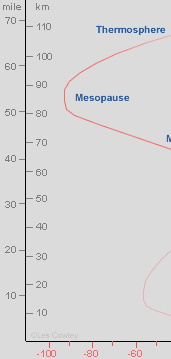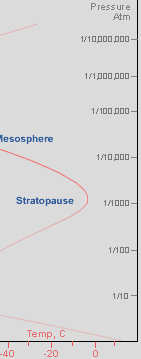
OPOD
What's New
Rays & Shadows
Water Droplets
Rainbows
Ice Halos
High Atmosphere
Tropopause
Ozone Layer
Mesosphere
Gravity Waves
Nacreous Clouds
Noctilucent Clouds
Rocket Trails
Airglow
Aurora
Zodiacal Light
Links & Resources
Search - Index
123456789012345678
| Mesosphere & Mesopause |
 |
||
|
|
Above the stratosphere's temperature peak at 50 km, temperatures fall precipitously. We are in the mesosphere or 'middle atmosphere'. At the base of the mesosphere the pressure is only 1/1000 of that at sea level and when the top is reached at 95 km it is a mere millionth. For practical purposes it is a vacuum. Temperatures there only have significance in influencing the mesosphere's molecular physics and chemistry rather than in any ability to heat objects like spacecraft or even dust. Temperatures decrease with height because heating by ultraviolet absorption by ozone falls off and, importantly, traces of carbon dioxide have a significant cooling effect. In the lower atmosphere CO2 acts as a so called greenhouse gas by absorbing infrared radiation radiated by the earth’s surface. In the rarefied mesosphere CO2 actually cools the atmosphere by radiating heat into space*. A temperature minimum of -90°C and lower is reached at ~85 km - the mesopause. Near here is the realm of the 'night shining' or noctilucent clouds. Beyond the mesopause temperatures rise again because of reduced radiative cooling combined with heating by absorption of short wavelength,<180 nm, UV radiation by O2, O atoms and N2.
|



